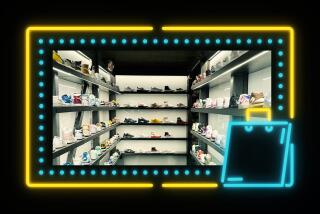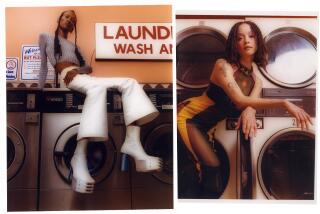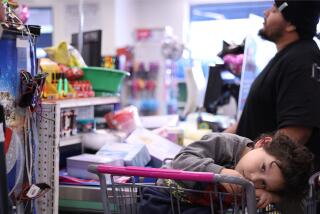New Wrinkle in Coin Laundries
- Share via
Like your first slow dance or your first bus ride, you probably remember your first trip to a coin laundry.
Maybe you were a freshman in college or the family washer broke down. When the socks and underwear ran out, the time had come to gather up loose change, stuff the dirty clothes into a pillowcase and leave your warm nest for the fluorescence, the linoleum and the electric churning of that great unwashed institution, the coin-operated self-service laundry.
Times have changed and so have Laundromats, the trademarked name belonging to Westinghouse Corp. that most people give to all coin-operated laundries. While drive-in movies and Horn & Hardart automats have largely moved onto the nostalgia ledger, self-service laundries survive--mostly because the young and the transient still don’t have their own machines and partly because coin-operated laundries have been evolving.
In San Diego County, you can work on your biceps at what is probably the world’s first laundry-gym. In Texas, you can work on your tan in self-service laundries equipped with sunning booths. In Florida Launderettes, you can get a cup of java at senior-citizen coffee klatches, and at 80 Duds ‘n’ Suds laundry franchises in 38 states, you can wash and watch wide-screen TV.
“The more progressive laundry store owners are aware that customers’ time is valuable--they want to accomplish as much as they can while they’re there,” says Richard Torp of the Coin Laundry Assn., headquartered in Downers Grove, Ill.
The association, founded in 1961, is a U.S. trade group that keeps the nation’s 40,000 self-service laundries au courant . At last count, says Torp, 16 million to 20 million American families were using coin laundries on a regular basis, with each washing three to five loads a week.
“The majority of customers are blue-collar types who don’t have machines in their homes or apartment complexes,” Torp says. The second biggest group of customers are college students, he adds, and an up-and-coming client base is the senior set.
“The number of retired customers has increased surprisingly,” Torp says. “They may even have their own equipment at home but they use the local Laundromat because it’s a social outlet.”
In the coin laundry of the ‘80s, Torp concludes, “life style is becoming very important.”
One day, when Lois Trabert was exercising in a public gym, she got the kind of idea that seldom makes it to the drawing board: Why not put exercise equipment in a coin laundry so people could work out while they wash their clothes?
Twenty years later, the Trabert family’s Clean and Lean laundry-gym in northern San Diego County is such a hit that they are considering offers to open franchises statewide.
“One guy drove down here all the way from North Hollywood,” says Gregory Trabert, Lois’ son and the store manager. “He took one look at the place and said: ‘This is it. Yeah, this is it.’ ”
Clean and Lean boasts new Sprint Circuit weight-training equipment and new Speed Queen washers and dryers. A full set of exercises, complete with warm-up and cool-down, takes just about as long as a full wash-and-dry cycle.
If you get so engrossed in exercising that you forget about your clothes, the Traberts are glad to transfer your load from washer to dryer--assuming they have time between orienting new customers (they get between three and six a day) and cleaning up.
Nearly half of Clean and Lean’s regular customers, many of whom buy unlimited memberships, use both washing and gym equipment. Most of the other customers only use the weight machines and a handful of people stay in the laundry area.
For laid-back customers--or as a post-workout reward--the laundry-gym has its own tanning booth and electronic massage board, each costing a couple dollars per use (the one-time gym fee is $3.50; a wash and dry is the standard $1.25). For die-hards, there are Clean and Lean T-shirts and gym bags.
In a tiny shopping center near San Diego State University, freshmen Kiesha Smith and Stacy Robinson share a sofa and a root beer as Alf cavorts on the big-screen television and their clothes spin-dry at the local Duds ‘n’ Suds.
This is their first visit ever to a coin laundry and they are very relieved at how nice it is. They even called their mothers back in Los Angeles to tell them about it.
Like Clean and Lean, Duds ‘n’ Suds is a family operation. Philip Akin Jr., got the idea in 1982 while a student at Iowa State University. Philip Akin Sr. gambled on his son’s hunch and wound up at the helm of a national firm, headquartered in Ames, Iowa, that has 80 franchises and just keeps growing.
Akin Sr. credits the success of Duds ‘n’ Suds to two ingredients. “We’ve created a nice atmosphere and we’ve kept it clean,” he says.
He estimates that more than half the Duds ‘n’ Suds franchises serve beer on the premises. The rest, like the San Diego store, could not get local liquor licenses so their bar offers soda, fresh popcorn and other snacks.
Across the room from Smith and Robinson, Jeff Pollick stuffs his clothes in a digital Maytag dryer and returns to the table to confront his psychology textbook.
Pollick is not interested in Alf; he has his eye on the game area in the corner. “The pool table’s kind of nice,” he says. “I usually try to get some studying done but this isn’t a very good study atmosphere.”
After two minutes with the textbook, Pollick gives up and wanders over to a bank of pinball machines in the corner. He gets in two games before it’s time to fold the clothes.
More to Read
Inside the business of entertainment
The Wide Shot brings you news, analysis and insights on everything from streaming wars to production — and what it all means for the future.
You may occasionally receive promotional content from the Los Angeles Times.










